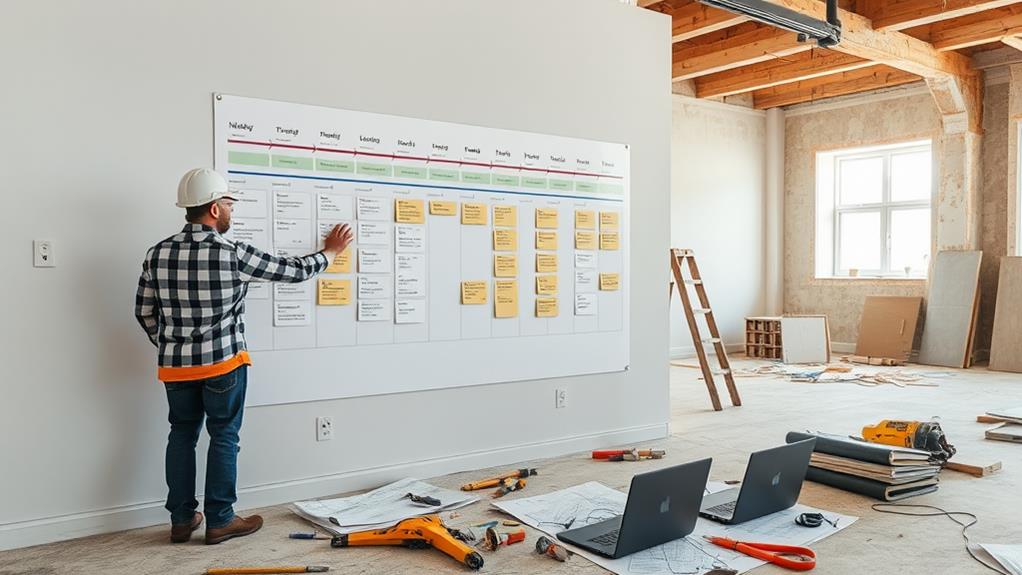Project scheduling is essential for keeping your renovation on track. Start by creating a visual timeline that breaks down tasks, identifies critical path activities, and allocates resources effectively. Build in buffer time to account for unexpected delays, typically 10-20% of estimated task durations. Maintain clear communication with stakeholders throughout the project, providing regular updates on progress and challenges. Utilize project management tools to streamline collaboration and track tasks efficiently. By mastering these scheduling techniques, you'll be better equipped to navigate the complexities of your renovation project and ensure its timely completion. Discover how to adapt to unforeseen challenges and celebrate milestones along the way.
Understanding Project Timeline Basics

Nearly every successful project hinges on effective timeline management. Understanding project timeline basics is crucial for keeping renovations on track and ensuring smooth execution. A project timeline is a visual representation of tasks, milestones, and deadlines, typically arranged chronologically. It serves as a roadmap, guiding stakeholders through the project's lifecycle and helping to identify potential bottlenecks or conflicts.
Key components of a project timeline include start and end dates, task durations, dependencies, and critical paths. Start by breaking down the project into manageable tasks and estimating the time required for each. Consider factors such as resource availability, potential delays, and external constraints. Identify task dependencies to determine the logical sequence of activities and avoid conflicts.
The critical path represents the longest sequence of dependent tasks, dictating the project's overall duration. Focus on these tasks to prevent delays that could impact the entire timeline. Regularly update and review the timeline as the project progresses, adjusting for unforeseen circumstances or changes in scope. Utilize project management software to streamline the process and facilitate real-time collaboration among team members.
Identifying Critical Path Tasks
The backbone of effective project scheduling lies in identifying critical path tasks. These are the sequence of activities that determine the minimum duration of a project. Any delay in critical path tasks directly impacts the project's completion date, making their identification crucial for successful project management.
To identify critical path tasks, start by listing all project activities and their dependencies. Estimate the duration of each task and determine which activities must be completed before others can begin. Use techniques like network diagrams or Gantt charts to visualize the project flow. The longest path through these interconnected activities becomes your critical path.
Key characteristics of critical path tasks include:
- Zero float time, meaning no flexibility in their start or end dates
- Direct impact on project completion if delayed
- Often the most complex or time-consuming activities
Regularly review and update the critical path as the project progresses. Unforeseen circumstances may alter task durations or dependencies, potentially changing the critical path. By closely monitoring these tasks, project managers can allocate resources effectively, address bottlenecks promptly, and keep the renovation on schedule.
Resource Allocation and Management

Once critical path tasks are identified, the next key step in project scheduling is resource allocation and management. This process involves assigning the necessary personnel, equipment, and materials to each task in the project timeline. Effective resource allocation ensures that tasks can be completed efficiently and on schedule, without overburdening any particular resource.
To begin, project managers should create a comprehensive list of all available resources, including their skills, availability, and associated costs. Next, they must match these resources to specific tasks based on requirements and expertise. It's crucial to consider potential conflicts or bottlenecks, such as when multiple tasks require the same resource simultaneously.
Resource leveling techniques can be employed to optimize resource utilization and minimize overallocation. This may involve adjusting task schedules or reallocating resources to balance workloads. Additionally, project managers should implement a system for tracking resource usage and performance throughout the project.
Regular monitoring and adjustment of resource allocation are essential to maintain project momentum. By staying vigilant and proactive in managing resources, project managers can address issues promptly, reallocate as needed, and keep the project on track for successful completion.
Building in Buffer Time
Prudent project managers recognize the importance of building buffer time into their schedules. This practice involves deliberately allocating extra time within the project timeline to account for unforeseen delays, complications, or unexpected challenges. Buffer time serves as a cushion, allowing for flexibility and reducing the risk of project overruns.
When incorporating buffer time, managers typically add it at the end of critical path activities or between major project phases. The amount of buffer time varies depending on the project's complexity, duration, and inherent risks. A common rule of thumb is to add 10-20% of the estimated task duration as buffer time.
Effective use of buffer time requires careful planning and ongoing monitoring. Managers should regularly assess the project's progress and adjust buffer allocations as needed. It's crucial to communicate the purpose of buffer time to stakeholders to manage expectations and prevent scope creep. While buffer time provides a safety net, it should not be viewed as an invitation to delay or procrastinate. Instead, it should be treated as a valuable resource to be used judiciously, ensuring the project remains on track despite inevitable setbacks.
Effective Communication With Stakeholders

Effective communication with stakeholders forms the backbone of successful project management. In renovation projects, stakeholders may include clients, contractors, suppliers, and regulatory bodies. Establishing clear channels of communication from the outset ensures that all parties remain informed and aligned throughout the project's lifecycle.
Regular status updates are crucial for maintaining transparency and managing expectations. These updates should include progress reports, potential challenges, and any adjustments to the timeline or budget. Utilize a mix of communication methods, such as email updates, in-person meetings, and collaborative project management tools, to cater to different preferences and ensure information reaches all stakeholders effectively.
Active listening and prompt response to stakeholder concerns are equally important. Address issues promptly to prevent minor problems from escalating into major setbacks. Encourage open dialogue and create an environment where stakeholders feel comfortable voicing their opinions and suggestions.
Document all communications and decisions to maintain a clear record of project developments. This practice helps avoid misunderstandings and provides a reference point for future decision-making. By prioritizing effective communication, project managers can foster trust, minimize conflicts, and increase the likelihood of project success.
Utilizing Project Management Tools
Project management tools play a vital role in streamlining communication and enhancing overall project efficiency. These digital platforms offer a centralized hub for task allocation, progress tracking, and resource management.
Popular options like Trello, Asana, and Microsoft Project provide intuitive interfaces that allow project managers to create detailed timelines, set milestones, and assign responsibilities to team members.
These tools often include features such as Gantt charts, which visually represent project schedules and dependencies. This enables stakeholders to quickly identify potential bottlenecks and adjust timelines accordingly.
Additionally, many platforms offer real-time collaboration features, allowing team members to update task statuses, share documents, and communicate within the context of specific project elements.
Adapting to Unforeseen Challenges

Despite careful planning, unforeseen challenges can arise during project execution, requiring teams to adapt quickly and efficiently. These challenges may include unexpected delays, resource shortages, or changes in project scope. To effectively navigate these obstacles, project managers must employ flexible strategies and maintain open communication channels with all stakeholders.
One key approach is to build buffer time into the schedule, allowing for minor setbacks without derailing the entire project timeline. Additionally, implementing a risk management plan can help identify potential issues early and develop mitigation strategies. Regular project status meetings provide opportunities to address emerging problems and adjust schedules accordingly.
When faced with significant disruptions, project managers should prioritize tasks, reallocate resources, and consider alternative solutions. This may involve fast-tracking certain activities or adjusting the project scope to meet critical deadlines. Utilizing agile methodologies can enhance adaptability, allowing teams to respond quickly to changing circumstances.
Ultimately, successful adaptation requires a balance between adhering to the original plan and remaining flexible enough to accommodate necessary changes. By fostering a culture of resilience and problem-solving within the team, project managers can effectively navigate unforeseen challenges and keep the project on track.
Celebrating Milestones and Progress
While adapting to challenges is vital for project success, recognizing and celebrating achievements along the way is equally important. Celebrating milestones and progress serves multiple purposes in project scheduling. It boosts team morale, reinforces commitment to project goals, and provides tangible evidence of advancement.
To effectively celebrate milestones:
- Identify key milestones in advance and communicate them to all stakeholders.
- Track progress visually using charts or digital tools to highlight achievements.
- Acknowledge both major and minor accomplishments to maintain momentum.
- Organize brief team gatherings or virtual meetings to recognize completed phases.
- Share progress updates with clients or upper management to demonstrate value.
- Offer small rewards or incentives for meeting critical deadlines or quality standards.
Celebrations need not be elaborate; even simple acknowledgments can have a significant impact. Consider sending congratulatory emails, displaying progress photos, or treating the team to lunch. By regularly recognizing achievements, project managers can foster a positive work environment, enhance team cohesion, and motivate continued excellence throughout the project lifecycle.
Frequently Asked Questions
How Do I Handle Conflicts Between Subcontractors During a Renovation Project?
To handle conflicts between subcontractors, maintain open communication, mediate disputes promptly, clearly define roles and responsibilities, encourage collaboration, and document agreements. If necessary, consult the project manager or general contractor to resolve persistent issues and keep the project on track.
What's the Best Way to Prioritize Aesthetic Choices Without Delaying the Timeline?
Picture a delicate dance between beauty and time. Prioritize aesthetic choices by:
- Pre-selecting design elements early
- Creating a decision timeline
- Involving key stakeholders promptly
- Maintaining open communication with contractors
- Being flexible with alternatives when necessary
How Can I Minimize Disruptions to Daily Life During a Home Renovation?
To minimize disruptions during a home renovation, create designated living spaces, establish a temporary kitchen if necessary, communicate regularly with contractors, plan for noise reduction, and consider temporary relocation for major phases. Maintain a flexible schedule and realistic expectations throughout the process.
Are There Specific Scheduling Considerations for Renovating Historic or Older Properties?
Renovating historic properties requires herculean patience and meticulous planning! Extended timelines are crucial, as unforeseen challenges often emerge. Prioritize thorough inspections, coordinate with preservation experts, and anticipate longer approval processes. Flexibility is key when dealing with centuries-old surprises behind every wall.
How Do Local Permitting Processes Typically Affect Renovation Project Timelines?
Local permitting processes significantly impact renovation timelines. They often involve multiple inspections, approvals, and potential revisions. Delays can occur due to backlogs, complex regulations, or unforeseen issues, necessitating buffer time in project schedules for permit-related activities.
Conclusion
Effective project scheduling is crucial for successful renovations. By mastering timeline basics, identifying critical paths, managing resources, and incorporating buffers, project managers can navigate challenges and maintain momentum. For instance, a recent hotel renovation in Chicago employed adaptive scheduling techniques to overcome supply chain disruptions, finishing only two weeks behind the original timeline. Utilizing project management tools and fostering clear communication among stakeholders further enhances the likelihood of meeting deadlines and achieving renovation goals within budget constraints.

